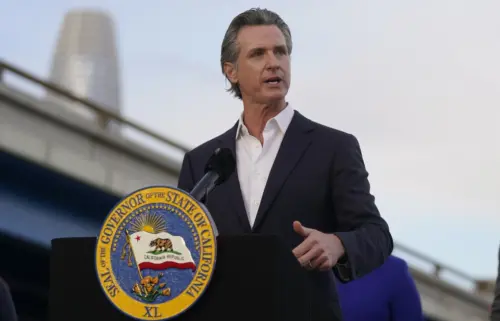Federal Reserve leaves its key rate unchanged but keeps open possibility of a future hike
By CHRISTOPHER RUGABER
AP Economics Writer
WASHINGTON (AP) — The Federal Reserve kept its key short-term interest rate unchanged Wednesday for a second straight time but left the door open to further rate hikes if inflation pressures should accelerate in the months ahead.
The Fed said in a statement after its latest meeting that it would keep its benchmark rate at about 5.4%, its highest level in 22 years. Since launching the most aggressive series of rate hikes in four decades in March 2022 to fight inflation, the Fed has pulled back and has now raised rates only once since May.
The central bank’s latest statement noted that the economy “expanded at a strong pace” in the July-September quarter and that job gains “remain strong.” And it reiterated that future rate hikes, if the Fed finds them necessary, remain under consideration.
But it also acknowledged that recent tumult in the financial markets has sent interest rates on 10-year Treasury notes to near 16-year highs and contributed to higher loan rates across the economy — a trend that helps serve the Fed’s goal of cooling the economy and inflation pressures.
At a news conference, Chair Jerome Powell suggested that the Fed was edging closer to the end of its rate-hiking campaign. He noted that the sharply higher longer-term rates could help lower inflation without necessarily requiring further rate hikes from the Fed. And he highlighted a steady decline in pay increases, which tends to ease inflation because companies may find it less necessary to offset their labor costs by raising prices.
The Fed chair expressed confidence that inflation, despite some signs of persistence in the most recent monthly data, is still heading lower even as the economy is still growing.
“The good news,” Powell said, “is we’re making progress. The progress is going to come in lumps and be bumpy, but we are making progress.”
The Fed chair said the central bank’s policymakers recognize that the effects of their rate hikes have yet to be fully felt in the economy and that they want to take time to assess the impact, another reason why the Fed may not feel compelled to raise rates anytime soon.
“Slowing down” the rate increases, Powell said, “is giving us a better sense of how much more we need to do, if we need to do more.”
Stock prices rose and bond yields fell as the Fed chair spoke to reporters, as investors interpreted his remarks to mean that the Fed may be done hiking rates.
“The (stock) market is convinced that the Fed is done,” said Michael Arone, chief investment strategist at State Street Global Advisors. “That may in fact be true, but they haven’t said that yet.”
Arone noted that hiring remains robust, that inflation remains persistently above the Fed’s 2% target and that the economy is still expanding at a healthy clip.
In his remarks, Powell cautioned that the central bank isn’t yet confident that its own key rate is high enough to reduce growth over time.
“The Fed,” Arone said, “continues to give themselves plenty of wiggle room in terms of what they’re going to do next.”
Powell himself suggested that Fed officials remain unsure about whether further rate increases might still be needed to defeat inflation. That stance marks a shift from earlier this year, when the policymakers had made clear that they leaned toward pushing rates higher.
“That’s the question we’re asking: Should we hike again?” Powell said.
Long-term Treasury yields have soared since July, the last time the Fed raised rates, swelling the costs of auto loans, credit card borrowing and many forms of business loans. Nationally, the average long-term fixed mortgage rate is nearing 8%, its highest level in 23 years.
Economists at Wall Street banks have estimated that recent losses in the stock market and higher bond yields could have a depressive effect on the economy equal to the impact of three or four quarter-point rate hikes by the Fed.
Those tighter credit conditions, though, have yet to cool the economy or slow hiring as much as the Fed had expected. Growth soared at a 4.9% annual pace in the July-September quarter, powered by robust consumer spending, and hiring in September was strong.
Consumer inflation has dropped from a year-over-year peak of 9.1% in June 2022 to 3.7% last month. But recent data suggests that inflation remains persistently above the Fed’s 2% target.
Market analysts say an array of factors have combined to force up long-term Treasury yields and couple with the Fed’s short-term rate hikes to make borrowing costlier for consumers and businesses. For one thing, the government is expected to sell potentially trillions of dollars more in bonds in the coming years to finance huge budget deficits even as the Fed is shrinking its holdings of bonds. As a result, higher Treasury rates may be needed to attract more buyers.
And with the future path of rates murkier than usual, investors are demanding higher yields in return for the greater risk of holding longer-term bonds.
What’s important for the Fed is that the yield on the 10-year Treasury has continued to zoom higher even without rate hikes by the central bank. That suggests that Treasury yields may stay high even if the Fed keeps its own benchmark rate on hold, helping keep a lid on economic growth and inflation.
Other major central banks have also been dialing back their rates hikes with their inflation measures having appeared to improve. The European Central Bank kept its benchmark rate unchanged last week, and last month inflation in the 20 countries that use the euro fell to 2.9%, its lowest level in more than two years.
The Bank of England also kept its key rate unchanged in September. The Bank of Japan, meanwhile, is inching toward higher borrowing costs, as it loosens control on longer-term rates.



